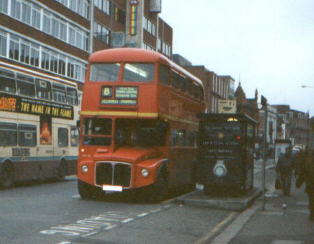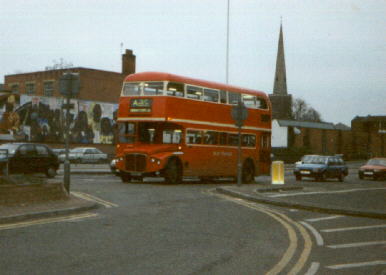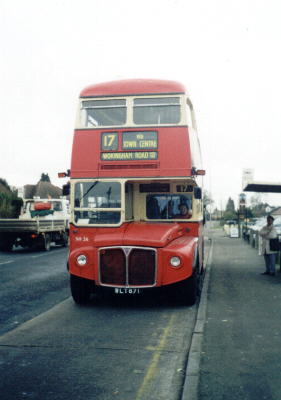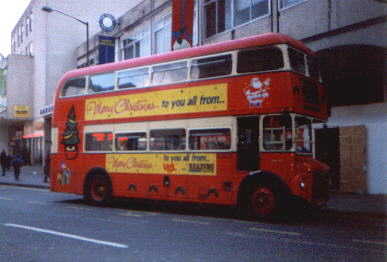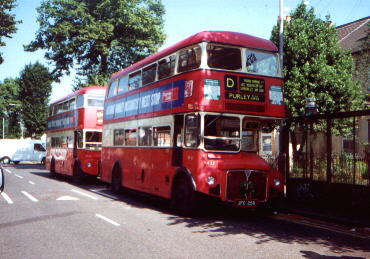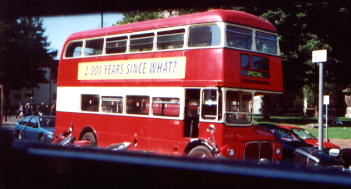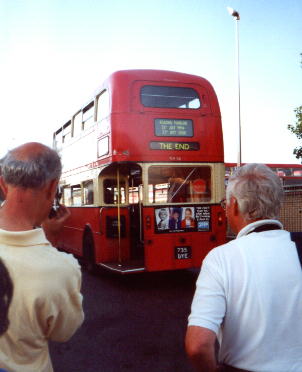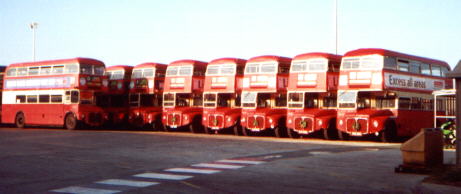Reading Mainline
www.buszone.co.uk
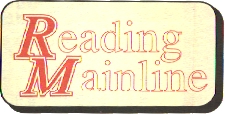
Reading Mainline was set up in July 1994 as the trading name of the Greater Reading Omnibus Company Ltd to directly compete with Reading Transport.
Reading Mainline operated a fleet comprised solely of AEC Routemaster buses, seen by many as the traditional English bus, with an open rear platform and a conductor. Interestingly however, this was the first time that a Routemaster had operated in Reading, the type originally being supplied almost exclusively to London Transport. Reading Mainline became the largest operator of Routemasters outside London, and before it had finished, the only operator of Routemasters outside London. The fleet eventually consisted of 45 Routemasters (though only 44 having fleet numbers allocated) and a loaned Leyland National solely for driver training purposes.
Reading Mainline's main competitive angles were, faster loading and journey times made possible by conductor operation, cheaper fares, the provision of a conductor to help passengers on and off and the operation along roads which were previously not served by Reading Buses. A Hail and Ride system was used on roads where bus stops had not been erected so people could get off a points which suited them.
The Reading Buses initial response to Mainline's first route, Line A, was to duplicate the service with a new service, the number 1, using brand new MetroRider minibuses, special FastLine branding and a timetable on a Limited Stop basis to operate slightly ahead of the Mainline vehicles. After Mainline had introduced further routes Reading Buses started a low cost unit, based at it's former engineering works at Kenavon Drive, operating minibuses with their fleetnames removed. Initially Optare City Pacers and Robin Hood bodied Mercedes Benzes from Newbury Buses were used on the first services, eventually routes 13, 22 and 31 competing against Lines H, F and E. Later MCW Metroriders and further Optare City Pacers were used, purchased from other companies.
On Saturday 28th October 1995 Mainline operated Stagecoach East London's RMC1485 (Registration number 485 CLT). It was visiting Reading for the Reading Buses open day on the Sunday and was being garaged by Mainline for the evening. This gave them the opportunity to run it on the Saturday, and so it spent the day on Line B. It was fitted with correct blinds for the route, and the platform doors it has fitted were left open when the bus was in motion.
In late 1996 Mainline found itself short of buses after rapidly introducing new routes. This led to newly acquired No.32 entering service in it's previous operators livery (BTS/London Sovereign). The fleet was also boosted for a few weeks by a long Routemaster Coach (RCL 2239, registration CUV 239C to be exact) hired from Blue Triangle to help out with the pre-Christmas rush. It was fitted with full blinds for the routes it operated on (usually Line A) and a door on the platform. Unlike with the Stagecoach RMC that visited the year before the doors were used when the bus was in motion. Their photographs are below:
No.32 on Line B in December 1996 on Friar Street
RCL 2239 on Line A on 12th December 1996 on Mill Lane, just past the former Reading Transport depot, which is now a shopping centre
Lines were introduced in the following order; A, B, E, H, F, X, C, J, D and 79. Lines D and 79 commenced after a service shake-up a few months after the take-over. At this time Lines B, J and X were all withdrawn, line D was an extension of some Line E journeys. Details are on the Reading Mainline Routes page.
Reading Mainline were bought out by Reading Buses in 1998, and the operation was guaranteed to continue as a separate identity for two years as part of the buyout contract. The buyout cost in total £700,000 - £250,000 for the vehicles and depot and £450,000 in debts. This led to Reading Transport making a loss for the first time in it's history, about £36,000 in the 1998/9 financial year. The Routemasters also took their place as Reading's oldest buses, and so it became Reading Buses' policy to seek their demise as quickly as possible to increase their average fleet age, and also to help restore profitability.
A few months after the take-over some service changes were made. New blinds had to be fitted to the Routemasters to cover these alterations. The numbers 71-9 were included on the new single letter blinds to allow the buses to operate football specials if required. In fact Reading Mainline was actually the company name used by Reading Transport on the contract for the football services, not Reading Buses as previous. Interestingly though, apparently a misprint, the number 17 was included, not 71. This led to a quite surprising event, never repeated. It took place on 26th February 2000, No.26 operated the 17, the only instance of a Routemaster ever being used on a Reading Buses route. It occurred during the week after Line A was withdrawn, Reading Buses found themselves 20 drivers short, and Mainline had a spare bus and crew. The crew could have been sent out on a Metrobus, because there was a Routemaster spare there seemed no reason not to use it. The Routemaster operated two round trips in the morning before returning to the depot due to trade union objections. This led to a decision being made, that if Mainline crews are used on Reading buses routes a standard Reading Bus should be used providing the driver has been type trained. If they haven't then an extra Routemaster should be placed on Line F, allowing a 25 to be taken off and it's driver. (This however would leave Caversham with a hole in the service!) Here is No. 26 at Tilehurst Bear Inn, the photograph was taken by Tim Wale:
In 1999 the lease ran out on the company's Cardiff Road depot, and so it was decided that the buses should be moved to the new Reading Buses depot in Great Knollys Street. The 24 operational buses were moved in a convoy on a Saturday evening after all the buses had run in from service. The final bus was adorned with a black ribbon, and driven by Mike Russell. Some items were broken up on site before the move, or sold, and final bits and pieces were moved during the following weeks. No. 23 was the first Routemaster out of the Reading Buses depot on the Sunday on the 79 for a Rugby match.
Routemaster No.37 was chosen as the 1999 Reading Buses Christmas bus, the bus selected each year from the fleet to display a special Christmas greeting from the bus company. It was the first and only Routemaster to display the Reading Buses logo, sadly though it was out of service for a two weeks in late December because of a major breakdown. Here it is in early January 2000.
Mainline's final day came on 22nd July 2000. By this stage only 12 buses remained, 11 of which operational for the day. The final peak vehicle requirement during the week was 10, and on Saturdays 7. Two buses may not seem like much cover, this situation only came about though in the last few weeks of the operation when odd buses were sold a week or two ahead of the final withdrawal. Reading Buses had Metrobuses on hand if desperately required, but they were never needed. The Routemasters proved reliable enough to cope on their own, the extra Mon-Fri duties being only at peak periods, meaning that there was time during the day for repairs if necessary. Services on the final day consisted of the usual timetabled journeys on the two remaining line D and F and also some extra services laid on specially for the occasion. The extra buses ran short-workings of the D and F, and were also used to provide duplicates of the final journey into town on line F. In total 11 buses ran that day, the entire operational fleet. The allocations (in order of leaving depot) were:
- D1 No.11
- F1 No.25
- D3 No.23
- F4 No.24
- F3 No.36
- F2 No.43
- D2 No.42
- X1 No.14 (Line F short-working)
- X2 No.18 (Line F short-working)
- X3 No.19 (Line D short-working)
- X4 No.20 (Line D short-working)
All buses were fitted with special blinds on the front advertising the last day, and wreaths on the front grilles. The buses also carried white cards advertising the last day above the bonnet for the week before the final day. You can just make out the special blind and wreath on No.23 at the Addington Road terminus of Line D, one of the special extra buses is behind.
At 1pm No.42 broke down in town and was swapped with No.19 on an extra which was opposite. The crew on No.19 took No.42 to the depot for repair, and after about 30 minutes they took it back and resumed their extra schedule. Two other Mainline buses visited during the day, the first was No.100, formerly No.31 (renumbered for the centenary celebrations at Usti nad Lebem in the Czech Republic in 1999) making a short appearance on Friar Street when it wasn't needed by a wedding party that had hired it for the day. Also, during the afternoon No.33, preserved by a local religious group visited. It was parked at St.Mary's Butts where Mainline often left buses on layover, especially when based at Cardiff Road. Here is the photograph of it, that I took through the window onboard No.42:
The last bus to enter the depot was No.36. It was driven by Mike Russell, the founder of Mainline, and was led by two other buses, No.14 at the front and No.18 in the middle. The procession was delayed for some time at Clivedale Road for photographs, and then had to proceed at funeral pace because the bus was so weighed down with people that on the way to Woodley from Calcot it had hit the Fords Farm bus ramp, and something had been knocked out of place! This meant the arrival at the depot was about 30 minutes late, all three buses unloaded enthusiasts outside the depot, and when unloaded No.14 and 18 entered the depot. No.36 waited for photographers, a photograph of the past and present Mainline staff was taken. When this was all done it too entered the depot. All three of the final Routemasters showed the destination THE END on the back with the following above:
- READING MAINLINE
- 23RD JULY 1994 ~
- 22ND JULY 2000
Here is the photograph that I took on No.36 going through the gates for the last time:
This is a photograph of all but the final three Routemasters lined up in the depot ready to depart for their new homes the next day. The final three Routemasters later came in and parked in front.
Over a year later on 23rd September 2001, former No.22 is on display at the Showbus rally at Duxford after an extensive refurbishment at the Marshall plant. It was one of a number of Mainline Routemasters purchased by Transport for London for refurbishment and reintroduction onto London's roads.
- Related sites to visit:
- AEC Bus Site Feature on Reading Mainline in January 2000
- AEC Bus Site Feature on Reading Mainline Last Day
If you think that there is anything about the company that has been missed, please feel free to email. All contributions for the site are welcome.
